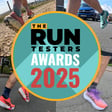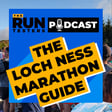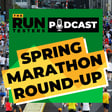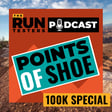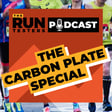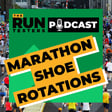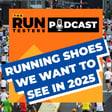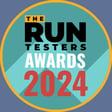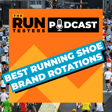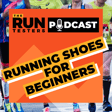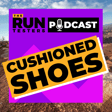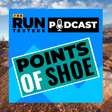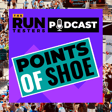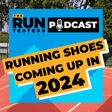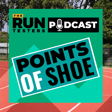Become a Creator today!Start creating today - Share your story with the world!
Start for free
00:00:00
00:00:01

How Gait Analysis Can Improve Your Running | With Performance Experts Human Powered Health
In this episode, we speak to performance experts Human Powered Health, a US company that uses leading sport science tools and technology to provide actionable data and insights for athletes.
Tom talks to Head Performance Physiologist Alyssa Younker to learn about gait analysis and how it can improve running for anyone from beginners to elites.
To find out more about Human Powered Health and the work they do, click here: https://humanpoweredhealth.com/
Big thanks to Fear of Tigers for the killer intro music. You can listen to more of his stuff over at https://www.patreon.com/fearoftigers
Transcript
00:00:04
Speaker
Hey, Tommy from The Rantesters. In this episode of the podcast, I'm going to be speaking to Human Powered Health, a company in the US that run assessments for athletes to look at various points of data and understand how they can use that information to improve their performance. Specifically in this episode, we're going to be looking at gate analysis. So if you're interested in finding out more about how your gate can impact your running, listen on.
00:00:38
Speaker
Hi, welcome Alicia to the podcast. Thank you so much, Tom. Thanks for having me. and now we We met a while back actually in Boston when I was, I think it was the day before I did Boston boston Marathon and and you guys invited me over to do some tests just to see and find out a bit more about my running and probably nothing that I could use the the day before the marathon. Probably not, no, but it was great, great data to get, yeah. Yeah, really interesting. And ah well, let's let's start by just talking a bit about human powered health. So you you work for human powered health. what What do you do and what is the aim of the the company? Yeah, of course. So I'm the head performance physiologist for human powered health Boston. So we have two labs in Boston. I oversee, you know, the lab operations for its tests. We also have a lab in Minnesota. That was our first lab. And so human powered health is a fairly new company. And just like in the name,
00:01:32
Speaker
We really want to empower people to take advantage of the tools that they have to make their health better. so It sounds cliche, but we know some people don't take advantage of data as they should or metrics and things like that to to really improve their health. And there are so many small changes we can help people make that have huge impact on their health. And so we give access to everyday people. Anybody can come into these tests to, you know, VO2MAX testing, lactate testing, We have a DEXA scan. and We do gait analysis, obviously, and some nutritional components like a sweat analysis or resting metabolic rate. And our our true passion is explaining these results to the people and giving them some actionable, I call it homework, some actionable recommendations that they can then go home, implement these recommendations, and then we can see how their numbers improve. So they they understand their data, where they're at. We help them to take the next steps to to improve those numbers overall health. Brilliant, and you guys do loads of different things at Human Powered Health. i went When you were talking me through some of the the tests that you do and some of the data you get back, today we're just going to be talking about gate analysis because we realized when we were chatting about this podcast that there was way too much to cover if we were going to try and do loads of other things as well. Gate analysis is is a really interesting one because I think
00:02:51
Speaker
A lot of runners, and we're going to talk specifically about running runners in this, I know you do cycling and other sports as well, but I think the thing about gate analysis is ah runners generally have heard of it and they often get told they need it, but in the UK especially, because I have not really worked with many sports performance companies that really go into too much depth with that over here, we sort of get it done in two running shoe shops and things like that and people think that's that's what it is. It's just to sort of buy shoes. so What exactly is gait analysis and and and why what do people need to know about it? Over and above, you need to get gait analysis.
00:03:29
Speaker
Yeah, so gate analysis, gate, like you said, it can be related to walking or running. So in this instance, we'll talk about running. And it's really just a method of looking at different metrics, kinetic, kinematic metrics that you exemplify throughout your locomotion. And so there's different ways to do this, right? Like you said, you can go to a running store. There's apps on your phone. We have a software on our treadmill. And all those different methods can give you different metrics to look at. And so first and foremost, with Gate, we never want to try to completely change anybody's form. We never want to completely change up the way they're running. But we want to try to identify a couple of small pieces that we see could have some room for improvement that could be easily changed. And so with Gate Analysis, I think it's important for
00:04:14
Speaker
anybody who spends a lot of time running and it doesn't even need to be ah a runner, you know, it could be a team sport athlete that's a soccer player running up and down the field for 90 minutes. Anybody who's had long-term overuse injuries because that could be due to their form or some imbalance in their gait. And so, you know, we can try to identify Like I said, areas for improvement on how their foot is hitting the ground, their arm movement, the force they're producing, stuff that we can we'll talk about years later. And so I think it's important for anybody who spends time running. It's such an overuse, prone activity. You're doing the same movement, repetitive over and over and over again. at One small asymmetry or
00:04:59
Speaker
And if ineffective metric can cause some pretty profound injuries. And so if we can help to just identify a couple of things and make some small changes, it can really help improve comfort and performance. Okay. Great. So Gates analysis, what does it actually cover? Because is it everything to every bit of movement that your, your legs and feet are doing during the, during the exercise? Yeah. And so it depends on what software or technique you're you're looking at. So we're fortunate our software, we do look at mostly the lower body. um And so as a physiologist, subjectively, we look at your upper body because that has a lot to do with your gait. But it's typically lower body, so hips all the way down to toes, and how as a system or as like I like to think of your lower body as linked chains.
00:05:47
Speaker
So how they're working together to produce force, to make sure you don't have too much ground contact time. How they're swinging in space. um So we like to think of it as like gravitational forces, how your limbs are moving. There's ideal ranges for flexion, extension of the hip, knee and ankle. There's ideal ranges for how far you're swinging, for where you want to hit the ground. So our our system here is really great because we can get all those metrics. Though, you know, other systems, they they tend to use joint angles, which is great. Like if you have ah an iPhone and you can do it ah at but at your local track and you can watch, it'll create the segments. I'm sure you've most people have seen on there. and Ours, we can look at the actual amount of force you're putting into the ground, which is awesome as well. So it's a combination of kinetics. So force you're putting into the ground, how you're reacting to that force. And then kinematics is, you know, your limb movement and where you are. Sounds like there's a lot to it. here There is.
00:06:44
Speaker
Good job. we've We've got a whole podcast on this. um so in For most people, for most beginners, we get a lot of questions on the channel when we're reviewing shoes with people asking about gait and getting your gait checked in in running shoe stores. For for those people that really don't haven't had it done before, what is the major difference between what you guys do and what you would get from, say, just going to the running store and and going on a treadmill? Yeah. So at a running store, I love that they do this. You know, they will typically watch you run, you know, up and down a couple of times within the store or outside. What they're usually looking at is the amount of supination or pronation that they see in your feet and ankles and maybe how you land and things like that. So they're looking at kind of the movement of your feet and ankles with the goal in mind being what shoe is going to help support this movement best, pretty much.
00:07:35
Speaker
Which is great, I still go and get that done, I get in the proper shoe, awesome. What we do is, you know, we look at where are some improvements that could be made with the whole system. So, ground contact time, ground reaction force, forward lean, like I said, those joint movements. And then we give recommended running drills, strength exercises, things like that to improve. So the running store is usually focused on the shoe, which is perfect. You need that. You need that good shoe that's going to support your ankle and foot movements. A gait analysis is focused on the whole picture of how your entire lower limbs are moving pretty much.
00:08:12
Speaker
Okay. All right. So if we look at ah running shoe stores as doing something a little bit different than what you're doing, when people come in to to speak to you guys, what is it? What the what is they they're really looking for? What are they trying to to to solve? Yeah, most people, they just have no idea if they have good running form. You know, usually if you go into the gym and use strength training, you can watch yourself in the mirror, make sure your form looks good and things like that. Unless you've had somebody record you running, they have no idea what they look like or if their form is good.
00:08:43
Speaker
and because they have nothing to compare it to and things like that. And so what they're looking for is that validation of, oh, you're you actually are running in a great manner. Here's a couple of things we got. So one, they're looking like, do I have good form or not? you know Because theyre they've if they've never had a coach or anybody tell them otherwise, they're kind of looking for that. And then the other thing is, like I said, just a couple of key tips on on where to improve. Everybody can always improve. um in some places and so they're usually just looking for a couple of key metrics that they could improve. I think it's probably safe to say that most of the people I know probably wouldn't ever look at getting any sort of analysis or anything unless they were maybe at the point where
00:09:23
Speaker
they were becoming a bit more competitive and they were trying to get PB's and you know they might be doing Boston Marathon or something and they really want to hit that sub three and they'll take anything they can get they'll try and fix anything and in their body. Is that the main sort of person that you get doing it or do you get all sorts of people coming to We get all sorts of people, like you said, we get that elite athlete that's looking for just that 1% advantage or improvement and then we get the person who's just starting off running and they want to make sure they have good mechanics in good form so that they don't get injured or have overuse injuries.
00:09:56
Speaker
And then we might get the person in between who has been running for a while and they just keep feeling this pain in their knee and they're not sure. And so that can also be almost used as a diagnostic tool or problem solving tool to figure out why they've been having certain pain or aches and things like that. So we we here at our lab, we get everybody on the spectrum, which is great because every conversation is different, every person is different and the recommendations are going to be different as well. That's good. I'll leave you on to my next question. so Is there an average gait analysis? so If somebody came in, would they all get the same thing or do you took review what they need and then modify it based on what what their sort of um strength and weaknesses are already? Yeah. yeah so Our overall goal at Human Powered Health is to treat everybody, you know make sure their experience is customized. and so i think I believe when you came in, you know we we typically ask them for three different speeds that they would like to test out.
00:10:50
Speaker
You know, let's talk about your so long slow run. What speed is that? Let's do, you know, your workout, upbeat tempo pace, and then let's do your ideal race pace. And so we like to customize it to those speeds because that's what you're actually going to be running at. So we should probably look at that for those speeds that you're spending that time at. And so those are going to be custom for for every person. And then the metrics that we look at are all the same, but then the recommendations are going to be different too. So if I get that elite athlete who's trying to get that 1% improvement, I'm going to give them probably a little bit more advanced drills or strength exercises. Whereas if I get that beginner or novice, I'm going to give them a little bit more basic drills and exercises to to make those improvements.
00:11:42
Speaker
Okay, so after you work with, is it do would you normally work with an athlete over a period of time or would they, so you you'd basically have somebody come in and say, I want to have a look at these things and you would monitor them ah based on the exercises that you give them or the changes in their, how their training goes over over time. Yeah, great question. And so, you know, we um like to think of ourselves as a testing center. So we don't want to replace your coach or your trainer or anybody. and So yeah they usually come in, we perform the assessment, we go over the results, we give them some recommended exercises and drills to implement into their routine, but we don't necessarily program for three months or tell them what to do each day. We don't want to replace their coach. And so with our data and our recommendations, we always tell them, you know, share this with your coach so they can share their results with their coach, with their physical therapist, with their doctor. And then we do recommend them coming back in, you know, it's four to six months to test again and see to make sure we're going in the right direction. You know, gait isn't going to change overnight. And so it does take some time to see some some differences.
00:12:57
Speaker
OK, so when we're when you're doing tests, and I think you might have my data there from from the test that we had. OK, that's going to be fun. I know we didn't have a lot of time to go through it when when I was over there. yeah um So when you're doing with the testing, what what sort of things are you are you really looking out for? Is there sort of levels where you're going, right, first of all, we're going to look at these things and then we're going to see and then delve into areas further if we think there's an area that's most more more relevant. Yeah, so there's kind of two or three main categories that we look at. um So overall, running a economy. That's basically how much energy you're burning when you run, how much energy you're using. So we want it to be low, right? We don't want to have to use a lot of energy at different speeds. And then we also look at elastic energy return. And so that's your ability to put force into the ground and then use that force to propel yourself forward.
00:13:48
Speaker
um So those are kind of two main categories along with the limb movement. So my joint, you know, my range of motion hit the flexion and extension and things. Those are all calculated by several metrics. You saw your profile. There's there's a lot of data we could dive into. And so the more popular and common ones we look at are like ground contact time. forward lean, cadence, overstrine, which are all really easy for the runners to understand, to conceptualize on you know why they might need to improve that. And then there are also good metrics to help try to improve with some really basic and simple drills. So those are the main categories that we look at.
00:14:25
Speaker
Okay, cool. And when you you're seeing people running, is there is there a common more common things than other things that you you spot straight away and say, yeah, we know we know what's happening here and you can make some big improvements very easily? Yeah, definitely. um with that you know With our lab, we see obviously a lot of runners and endurance athletes. And so, dead elastic energy return is usually pretty low. They're not as as poppy, um you know, quick on the ground, quick off the ground kind of thing. And so, you know, our recommendation is usually strength training. I cannot say that enough for endurance athletes, you know, unfortunately.
00:15:03
Speaker
Not everybody does it and I know it takes some time out of your day but that strength training, plyometrics, box jumps, more power and explosive movements really help that elastic energy return and so we're seeing that and that also goes into ground contact and so people are leaving their foot on the ground a little bit too long not popping it off the ground like they should. Those are those are the two most common ones that we see. and Okay, and if you were to help people to not do that so much, what would what would their plan look like and and what sort of things can they expect to be doing to actually improve? Let's look at the sort of elasticity um side of it. It would depend on the level of athlete too, right? um So it can be simple drills, A skips, B skips,
00:15:49
Speaker
you know, high skips, things like that, just incorporating that into your warmup. Those are a great part of a warmup. If somebody already does that and they're more on the elite side, I would give them some bounding exercises, some plyometrics, ankle hops, box jumps and things like that to increase your efficiency at landing on the ground and then quickly coming back off the ground. So like you're running on hot coals kind of, uh, and then in the weight room, just general explosive movements as well. Those high, those box jumps. Um, and then also powerlifting, uh, exercises if they're at that elite level too. Quite a lot to do i to add to add to my list.
00:16:28
Speaker
You know, it's all a scale, right? So I would never, you know, somebody comes in, we never throw 20 exercises at them. we We give them, like I said, two or three, hone in on, you know, just a couple of things. It's not so overwhelming. Okay. And what would you say is, I'm a coach and I do have to look at people's running form and things like that. But I always have sort of a level of it where some things I'll look at and go, that really needs to be fixed. That's that that's a fundamental problem that either is you know it might cause an injury further down the line, or it it might just be making their running really hard to do. And then some things where you look at it and you go, it yeah that that might help a bit, that's going to be a marginal gain, but it's not a concern. how do you sort of What are the things that crop up that you see where they sort of fit into those two areas?
00:17:13
Speaker
Yeah, choose your battles, right? um I think yeah you know I'd call this like a red flag, right? So in our system, we can see asymmetries between the left and the right side. If we see really large asymmetries, like greater than 10%, we know based off of research that can lead to injury and decreased performance. So, a major one we look at is, are you having large differences between your left and your right side? And we know, especially for running, that over and over, you know, repetitive movement over time, some of those asymmetries could lead to injury. So, that would be something that would determine whether we, you know, pick on that one to help improve as well.
00:17:52
Speaker
And then just based off of talking with a person, you know, their injury history, if they've always had an injury on one side or in one certain joint, then maybe seeing what that joint is doing during the gait analysis and seeing if there's room for improvement. Well, I'm sure we'll swap some of those things in a minute when we look at my data. that's um So so we we do a lot of running shoe reviews. We test a lot of running shoes over the run testers. I know from speaking to you that you you you don't do the same thing that running shops do where you where you they might suggest a shoe based on on how your gate is. But how does how do running shoes play into what you do? do do you Do you learn things about maybe the shoe isn't right or that might be what's causing it? Can you see those things in the analysis?
00:18:36
Speaker
Yeah, so typically if somebody is interested in a couple of pair of shoes, they can bring them in and we can compare the shoes as well. So they can do the same speed with two different shoes and it'll tell us the differences between their economy, their efficiency, their contact time, the shoe absorbency. So we can directly compare the two shoes and see which one is you know more economical for them as well. But, you know, we're not shoe experts. So that's why I think it's still great, you know, to combine these two different types of gait analyses with the running store as well. and Because I have I don't have the knowledge about all the different shoes that are out there and more biomechanics related. And so if somebody brings in two pairs of shoes, I can tell them the metrics, you know, that we see behind them. um But then I think it's still great to have a relationship with the running store, and send them back there. And here we
00:19:22
Speaker
send them with their gate analysis to the running store about great relationship with some and they can look at that and then also watch themselves and then do do a shoe analysis and see what shoe is best for the person. But yeah, for our software we can directly compare to two different shoes if you know the athlete wants to see ah which one they're moving more efficiently in. And how, if if you've looked at an athlete running in different shoes, how how different can it be at the the two shoes? Yeah, it could be pretty different. As you can imagine, right, if you're using kind of like a trainer versus a racing flat, there's differences there. um But we've seen some people bring in maybe version one of a shoe versus just version two. And, you know, there's always slight changes that they make. And so the person wants to know, like, is it okay for me to transition into version two right now?
00:20:10
Speaker
And so sometimes we'll see, well, actually, you know you might want to look at a different shoe because you're this version too is causing you to have some different changes in the way you land, your ground contact time, and things like that. So we've seen some some pretty pretty interesting changes between actual same brand shoe, just like the next version, and I won't name any. But yeah, it's it's been actually interesting doing shoe comparisons. It's really interesting. I'd love to love to test that out. I'd love to spend a whole week at the the lab just going through my pile of shoes and seeing what I should and shouldn't be wearing.
00:20:50
Speaker
All right, so um let's have a look. So when when I came over to to visit you guys over in Boston, I did i did the test, I did the gain analysis test and you pushed me quite hard to to get some to get some data back. and So I thought it would be useful if we just have a look at that and see what it tells. I know you gave me a bit of an overview when when we when we when we spoke, but it'd be great to have a look at the data you get for forgot for me and just see what that actually means and if I'm getting it completely wrong in terms of how how I run. Yeah, would love to. And i've I've got it pulled up on my screen right here. So we had to do three different speeds, 12, 14 and 16 kilometers per hour. um And so yours it in our software, it gives you a runner's profile. And so your runner profile is an eco sprinter, which is fantastic. That's the best overall that you want to be. So congrats. And that is basically, that's going to be based on um all the different metrics that it gives us, different demographics and things like that. And so the EcoSprinter is the best combination of performance and injury prevention. So a couple of other profiles that are out there typically are like a quick stepper, a constant glider, and things like that. And so most of them
00:22:04
Speaker
either lean really heavily towards good injury prevention but not great performance or the other way around really good performance but you know more prone injuries so that the eco spreader is the best the best overall so see you nice I'll take I'll take that yeah the other guys would be annoyed about that ah hello And then you're running economy overall. So the amount of energy you're you're burning while you're running was very low, which is good. So it gave you you know an A plus grade for all three of your speeds, which was awesome. And then you know some of the metrics that you and I talked about that could be improved upon.
00:22:40
Speaker
um where you're forward lean. And so for you, you're kind of upright a little bit too much. And so while we're running, we want a little bit of a like two to 5% forward lean. That just helps with momentum. It helps that when you do put your foot down into the ground, it's at an angle to pull yourself forward instead of just straight up. And so, you know, some recommendations we would give you are some almost some sprinting drills. um So, leaning up against a wall to do high knees, to do butt kicks, to do fast feet, things like that to get you in that more angled forward position. Your ground contact time was fantastic. Your cadence was great. I think, let's see, one more.
00:23:24
Speaker
One more thing I had for you here, we look at foot strike as well. So where on your foot you're striking the ground. um So for these trials, you were more in between the mid-foot and the heel. And so, you know, we don't need to be running our toes necessarily, but we definitely don't want to be heel striking. And so we want to make sure we don't go all the way back to that heel. So some drills that we would give you would be simple A skips, B skips, ankle hops, things like that to push you forward on the forefoot of your foot. Interesting. Well, that's the bit you talked about there with the the leading forwards. so And then there's a thing with reading clubs where they they they talk about lifting yourself up so that you're sort of pulling your body up straight. Is that is that as as a general rule? just ah Is it like it' just a little bit of a lean, just so?
00:24:13
Speaker
Yeah, if you think two to five percent, it's it's very minimal. And what I always when I recommend to people is it's not leaning at the shoulders, right? We don't want to round our shoulders. It's a slight hinge of the hip, basically. And if you think about it, the ideal place that you strike the ground is you know slightly under your hip. And so if you are completely straight up and you strike the ground under your hip, that force is going to put you vertical. Whereas if you have a little bit of a forward lean and you're striking the ground this way, that force is going to have more more of a horizontal nature to it. So more horizontal propulsion, which is what you want to propel yourself forward, not just just going... Yeah. you Do you get the opposite of that quite a lot as well, where people are really leaning too far forward when they're running? Not as much actually. So most of the time we see people are nice and not on board, but they're they're usually more straight up than than the forward lean.
00:25:06
Speaker
okay Okay, interesting. And then the the bit with the striking. Now, I found that quite interesting because I've always thought that of myself as a midfoot striker. And ah fairly recently, I've started to see that the back of my shoes wear down a bit more. in in the um It's not on the outside of of the shoes. And it's really annoying because a lot of the new super shoes that you get, the the carbon plate ones, have really little bits of rubber on the outside and I keep destroying them very, very quickly. and Because I seem to be, it's almost like I'm hitting the midsole, then I'm sort of scuffing it with my heel when I come up. And I don't think I used to do that. It seems to be a new thing that I've developed as ah as as I've got older. So how would, if that if that was, here's what I do, how would you help me not not, solve that problem over time. Yeah and so you know our bodies change over time so we have to adapt our training over time like you know with any aerobic and cardiovascular training same thing with biomechanics and neuromuscular function we have to continue to to train our body to you know move the way we want
00:26:09
Speaker
to move. So incorporating, you know, more of those explosive drills where you have to be on the balls of your feet, just tiptoe walking and tiptoe jumps as well would help. And then with a lot of these too, with cadence, with arm swing, with heel striking, if you just dedicate a couple of minutes during your run to really focus on those things, that helps as well. You know, it's hard to focus on at the entire 12 mile run, but if you say, okay, the next five minutes, I'm really going to focus on my arm swing, you know, or I'm really going to focus on my, my foot strike, almost like that. And then take 10 minutes mentally off to relax and then, okay, now I'm going to focus on it again. So, you know, also implementing those changes throughout your run to dedicating, you know, time to think about it and focus on those as well help. So, aside from that, is there anything else that you you noticed in my ah data to that that's interesting to to know? I know there's about three pages of stuff that you sent across to me.
00:27:08
Speaker
There's a lot of data, right? um You know, going back to the whole like supination and pronation too with the running store and things like that. That's something that we don't necessarily try to change in somebody. Everybody either supinates or pronates or is you know neutral. And so what we do is we just make them aware of it and say, you know, hey, it looks like you're a supinator. Make sure you know that when you buy your next shoe and you want a shoe that supports that and supports your foot in that motion. With yours, let's see, we had some um some larger degrees of step separation. So that meant, and I think it was, especially when we got in the faster speeds. So as you were running, where you were planting your foot got a little bit farther and farther away from your midline. So that's that step separation.
00:27:55
Speaker
And we see that especially in the faster speeds too. um And so that could be an indication of tight abductors kind of pulling your your legs out. It could you just be basic mechanics of running at those faster speeds. So some recommendations we would give would be doing strides or 100 meter sprints and things like that after your longer runs just to get that form down and keep your feet kind of towards more the mid light and not have them land outside as much. But yours was really good. Right, I'll take that, yeah. You are great. Yeah, you were on par with an elite level marathoner for the majority of your metrics. These are just... I'm going to use it as a quote on... Please do. Love me out. So there's a lot of things that you can do with the data that you get and there's obviously a lot of changes you can modify over time, but is there a risk? Should people worry about all these things at the start of their running or is it something I often, I was talking to a friend the other day who's fairly new to running and he was asking about all these different things about form and how we should be using his arms and everything. And my view on it is always your body does adapt over time. If you're completely new to it, it's like an alien thing to do, isn't it, running? And you're not going to get your form right. But the body does sort of learn quite well how to do things. I suppose that's the same thing with like sort of leaning forward a bit. Your body will adapt
00:29:25
Speaker
alongside it and and and and learn how to run um effectively. But um how do you if somebody comes in and and is completely new to running, do you have to be very careful with them? and so Well, actually, these are things you you don't really need to worry too much at the moment until you get to the point where you know you are being running a bit more competitively and running longer distances and it might become more of ah a problem. Yes, of course. Like you said, the body is really good at figuring things out. So if you go out for a run several times a week, it's going to figure out the best way to move. If somebody was new and coming in, it can be extremely overwhelming, all of these metrics. And so like with anybody, we only choose two to three to talk about.
00:30:03
Speaker
And it's going to be the two to three that are, for somebody new, important for injury prevention. And so, you know, the large asymmetry is between left and right. If we see any big differences, we know that that is a ah big indicator of risk for injury. We're not going to be too concerned with the forward lean probably because there's, you know, not a lot of risk to that. That's mostly for performance. um We're not going to be too concerned about maybe ground contact time at the beginning because we just want them, you know, to continue to go and we're just going to give them some really basic drills and simple exercises to implement and then have them come back in six months and then see what metrics still need to be improved upon and then we can start to dive in a little bit more. But at the beginning, we pick two to three that are really going to help prevent injuries basically and not focus too much on the performance quite yet.
00:30:51
Speaker
Another question I had is just that around, it sort of follows on from that. So I get a question a lot around um people who are trying to get faster and having misunderstanding or not quite understanding how cadence works. And if you should you if you if you're trying to get faster and you're upping a mileage, should you try and increase your cadence or should you try and improve increase your stride length? It's all dependent on the person, which is funny. every but Every body is different anatomically. I think that it depends on the other things they're doing for training because increasing cadence is going to be a little bit easier than increasing stride length. of fish We can and increase stride length, but we can do it inefficiently by heel striking.
00:31:37
Speaker
right? Or we can get stronger and increase stride length that way by being able to push ourselves farther per per each stride. um So, I get really wary about people trying to increase their stride length. I want to make sure they're doing it efficiently and that they're strong enough to be doing it and that they're not just flailing their leg out there to reach as far as they can and hitting their heel first and pushing all that momentum into their knee and causing injuries. And so, I think, you know, you can increase stride stride length by increasing your strength and be able to push to yourself farther per per stride. um But, you know, increasing cadence is also it's probably going to be the easier way and the the safest way to to not cause any any injuries.
00:32:20
Speaker
All right, so we've talked about all of the benefits and what you can get from the data and how you use that data, but are there any limitations to gate analysis? Are there is this other blind spots, I suppose, where you know people have questions that you you can't quite answer, you need other things to to learn? Definitely and you know, I'll be straight up, right? I work here obviously but I'm not, you know, not blind to the the disadvantages ah of what we do and you know, but first and foremost here, we do it on a treadmill. Not everybody loves treadmills, I hate treadmills, you know? Not everybody's gait is gonna be exactly the same on a treadmill either. But the workaround and behind that is maybe this isn't exactly how you're moving out out on the track.
00:33:00
Speaker
But we can use this as a starting point and then come back in six months and see how you've improved. So you're still getting really good, useful data. Whereas, you know, if we did just a video analysis on the track, that's still great, but we wouldn't be able to get forced ground contact time and things like that. um so So that's the first one is just the nature of being on a treadmill. Everybody knows it's it's a little bit different. And the other part is we're getting people in 30 second snapshots where they're fairly rested. You know, we had you do probably a five to 10 minute warm up and then we just do 30 seconds. So, you know, it's not an indication of how you're going to feel at the end of the marathon. You know, your gate is probably going to be very different at the end of the marathon versus versus the beginning. But just logistically and practical, right? We can't have you run a marathon in here on the treadmill. So those are the two, but it's still an extremely useful test and extremely useful data points that you can get from it, at least from tracking over time. And if you're, you know, if we see weaknesses in this 30-second snapshot or when you're relatively fresh, I can guarantee you we're going to see those weaknesses at the end of your marathon when, you know, you've gone 25 miles already. and so
00:34:12
Speaker
Besides those two, they're, like you said, just cautioning people to not take every single metric and try to change every single thing overnight as well. We we try to do a really good job of giving them two to three things to focus on, a couple of drills and strike up exercises to implement, and then it goes from there. and And how do you see that progression over time? So what are your longest people athletes that you work with? How long have you worked with them? And and and what's that sort of process look like? Because I could see it being a lot of people looking at it going, oh, I'm going to nip in there. They're going to tell me what I need to do. That's me done. I never hear from them again. Then I just have a list of things that I need to work on. But that's not how you guys work, is it? Not typically. No, we like them to come back in four to six months. We have only been open since November. yeah um Here in Boston, we haven't had any returners yet. I think I had my first returner coming in a couple of weeks. So it'd be exciting to see that. The lab in Minnesota, they've been open for about a year and they've had several people return. um And the most typical thing that they see is, you know, that elastic energy has improved um because of those skipping drills, the plyometrics and things like that.
00:35:23
Speaker
So, yeah, I am excited to start getting returning athletes too to see ah how their gate has improved. I bet. Yeah, no but it'd be really interesting to just just, if you had been following, it's the same thing with anything like physio and stuff like that where, you know, if you do follow the things, you want to see the impacts of those things, but it quite often doesn't it doesn't happen over a long term. Okay, that's really interesting. um I think I've got quite a lot of information to work on now to to try and to try and make to make some improvements. So thank you so much for for talking us through all of that. I know we're going to at some point talk through some of the other areas that you cover and there are loads of different things that you do analysis of for athletes. So um I'm we're looking forward to diving into to some of those as well. And I think, yeah, it was a smart move to do getting answers in one podcast because I definitely could have asked all these questions along with the other things as well.
00:36:15
Speaker
Yeah, I would have fallen into rabbit holes with lots of things, so we'll we'll dedicate each episode to a topic. Brilliant. Well, thank you so much. And we'll speak to you again soon. Yeah, we'll do. Thank you. This episode of the podcast was presented by Tom Wheatley and his guest was Elisa Juncker. The podcast was produced by Tom Wheatley. To find out more about human-powered health, click the link in the podcast notes.
